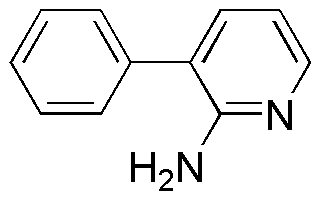3-Phenyl-pyridin-2-ylamine is widely utilized in research focused on:
- Pharmaceutical Development: This compound serves as a key intermediate in the synthesis of various pharmaceuticals, particularly in the development of drugs targeting neurological disorders.
- Material Science: It is used in the formulation of advanced materials, such as polymers and coatings, enhancing properties like durability and chemical resistance.
- Organic Synthesis: Researchers employ it as a building block in organic synthesis, facilitating the creation of complex molecules with applications in diverse chemical industries.
- Biochemical Research: The compound is instrumental in studying enzyme interactions and biological pathways, aiding in the discovery of new therapeutic targets.
- Agrochemicals: It finds applications in the development of agrochemicals, contributing to the formulation of effective pesticides and herbicides that improve crop yield.
General Information
Properties
Safety and Regulations
Applications
3-Phenyl-pyridin-2-ylamine is widely utilized in research focused on:
- Pharmaceutical Development: This compound serves as a key intermediate in the synthesis of various pharmaceuticals, particularly in the development of drugs targeting neurological disorders.
- Material Science: It is used in the formulation of advanced materials, such as polymers and coatings, enhancing properties like durability and chemical resistance.
- Organic Synthesis: Researchers employ it as a building block in organic synthesis, facilitating the creation of complex molecules with applications in diverse chemical industries.
- Biochemical Research: The compound is instrumental in studying enzyme interactions and biological pathways, aiding in the discovery of new therapeutic targets.
- Agrochemicals: It finds applications in the development of agrochemicals, contributing to the formulation of effective pesticides and herbicides that improve crop yield.
Documents
Safety Data Sheets (SDS)
The SDS provides comprehensive safety information on handling, storage, and disposal of the product.
Product Specification (PS)
The PS provides a comprehensive breakdown of the product’s properties, including chemical composition, physical state, purity, and storage requirements. It also details acceptable quality ranges and the product's intended applications.
Certificates of Analysis (COA)
Search for Certificates of Analysis (COA) by entering the products Lot Number. Lot and Batch Numbers can be found on a product’s label following the words ‘Lot’ or ‘Batch’.
*Catalog Number
*Lot Number
Certificates Of Origin (COO)
This COO confirms the country where the product was manufactured, and also details the materials and components used in it and whether it is derived from natural, synthetic, or other specific sources. This certificate may be required for customs, trade, and regulatory compliance.
*Catalog Number
*Lot Number
Safety Data Sheets (SDS)
The SDS provides comprehensive safety information on handling, storage, and disposal of the product.
DownloadProduct Specification (PS)
The PS provides a comprehensive breakdown of the product’s properties, including chemical composition, physical state, purity, and storage requirements. It also details acceptable quality ranges and the product's intended applications.
DownloadCertificates of Analysis (COA)
Search for Certificates of Analysis (COA) by entering the products Lot Number. Lot and Batch Numbers can be found on a product’s label following the words ‘Lot’ or ‘Batch’.
*Catalog Number
*Lot Number
Certificates Of Origin (COO)
This COO confirms the country where the product was manufactured, and also details the materials and components used in it and whether it is derived from natural, synthetic, or other specific sources. This certificate may be required for customs, trade, and regulatory compliance.


